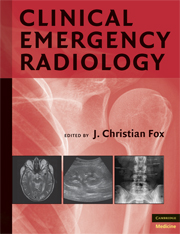Book contents
- Frontmatter
- Contents
- Contributors
- PART I PLAIN RADIOGRAPHY
- PART II ULTRASOUND
- 12 Introduction to Bedside Ultrasound
- 13 Physics of Ultrasound
- 14 Biliary Ultrasound
- 15 Trauma Ultrasound
- 16 Deep Venous Thrombosis
- 17 Cardiac Ultrasound
- 18 Emergency Ultrasonography of the Kidneys and Urinary Tract
- 19 Ultrasonography of the Abdominal Aorta
- 20 Ultrasound-Guided Procedures
- 21 Abdominal—Pelvic Ultrasound
- 22 Ocular Ultrasound
- 23 Testicular Ultrasound
- 24 Abdominal Ultrasound
- 25 Emergency Musculoskeletal Ultrasound
- 26 Soft Tissue Ultrasound
- 27 Ultrasound in Resuscitation
- PART III COMPUTED TOMOGRAPHY
- PART IV MAGNETIC RESONANCE IMAGING
- Index
- Plate Section
21 - Abdominal—Pelvic Ultrasound
from PART II - ULTRASOUND
Published online by Cambridge University Press: 07 December 2009
- Frontmatter
- Contents
- Contributors
- PART I PLAIN RADIOGRAPHY
- PART II ULTRASOUND
- 12 Introduction to Bedside Ultrasound
- 13 Physics of Ultrasound
- 14 Biliary Ultrasound
- 15 Trauma Ultrasound
- 16 Deep Venous Thrombosis
- 17 Cardiac Ultrasound
- 18 Emergency Ultrasonography of the Kidneys and Urinary Tract
- 19 Ultrasonography of the Abdominal Aorta
- 20 Ultrasound-Guided Procedures
- 21 Abdominal—Pelvic Ultrasound
- 22 Ocular Ultrasound
- 23 Testicular Ultrasound
- 24 Abdominal Ultrasound
- 25 Emergency Musculoskeletal Ultrasound
- 26 Soft Tissue Ultrasound
- 27 Ultrasound in Resuscitation
- PART III COMPUTED TOMOGRAPHY
- PART IV MAGNETIC RESONANCE IMAGING
- Index
- Plate Section
Summary
INDICATIONS
Abdominal-pelvic ultrasounds ordered or performed in the ED are used to diagnose life-threatening obstetrical or gynecological diseases that may require emergent surgery. Any pregnant patient with lower abdominal pain with or without vaginal bleeding requires an ultrasound in order to rule out an extrauterine gestation (ectopic pregnancy). Nonpregnant patients with lower abdominal pain, pelvic pain, or tenderness on bimanual examination are also candidates for a pelvic ultrasound in order to rule out ovarian torsion or tuboovarian abscess. Pelvic ultrasound is also capable of helping guide the emergency physician in the management of other nonemergent obstetrical/gynecological disease processes, such as incarcerated uterus, abnormal intrauterine pregnancies, no definitive pregnancies, and ruptured ovarian cysts.
DIAGNOSTIC CAPABILITIES
The following entities are readily diagnosed using abdominal-pelvic ultrasound:
Extrauterine pregnancies
Incarcerated uterus
Live intrauterine pregnancies (LIUPs)
Intrauterine pregnancies (IUPs)
Abnormal intrauterine pregnancies (AbnIUPs)
No definitive intrauterine pregnancies (NDIUPs)
Ovarian torsion
Tuboovarian abscess
Ovarian cysts (OCs)
Uterine fibroids
Gynecological cancer
IMAGING PITFALLS/LIMITATIONS
There are several potential limitations to abdominal-pelvic ultrasound:
Transabdominal ultrasound imaging — Obesity can frequently interfere with the quality of the image displayed by providing further distance between the transducer and the area of interest. An unfilled or small bladder bowel allows bowel to become interposed between the peritoneum and the uterus, causing the sound beam to scatter and thus produce poor imaging of the pelvis.
[…]
Keywords
- Type
- Chapter
- Information
- Clinical Emergency Radiology , pp. 313 - 324Publisher: Cambridge University PressPrint publication year: 2008

